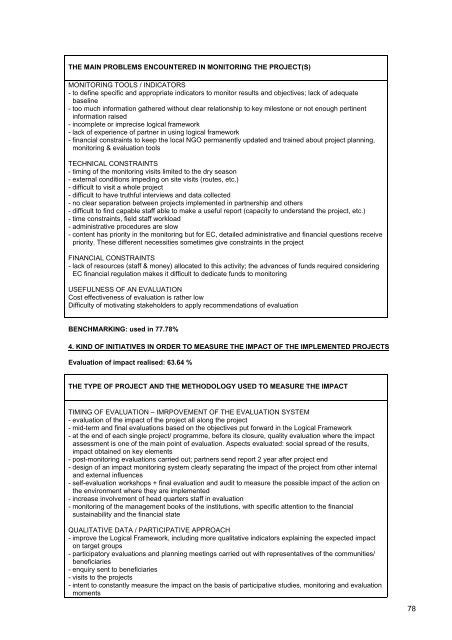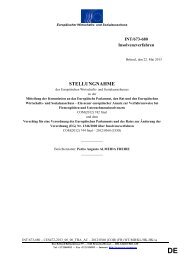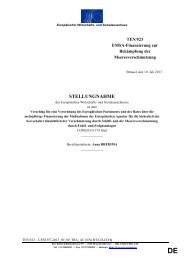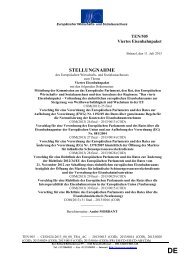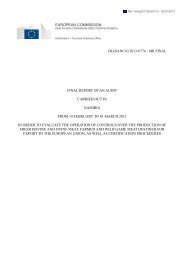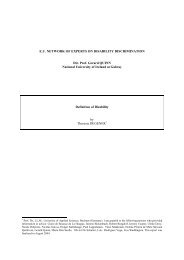INFORME DEL SEMINARIO REGIONAL
INFORME DEL SEMINARIO REGIONAL
INFORME DEL SEMINARIO REGIONAL
Create successful ePaper yourself
Turn your PDF publications into a flip-book with our unique Google optimized e-Paper software.
THE MAIN PROBLEMS ENCOUNTERED IN MONITORING THE PROJECT(S)<br />
MONITORING TOOLS / INDICATORS<br />
- to define specific and appropriate indicators to monitor results and objectives; lack of adequate<br />
baseline<br />
- too much information gathered without clear relationship to key milestone or not enough pertinent<br />
information raised<br />
- incomplete or imprecise logical framework<br />
- lack of experience of partner in using logical framework<br />
- financial constraints to keep the local NGO permanently updated and trained about project planning,<br />
monitoring & evaluation tools<br />
TECHNICAL CONSTRAINTS<br />
- timing of the monitoring visits limited to the dry season<br />
- external conditions impeding on site visits (routes, etc.)<br />
- difficult to visit a whole project<br />
- difficult to have truthful interviews and data collected<br />
- no clear separation between projects implemented in partnership and others<br />
- difficult to find capable staff able to make a useful report (capacity to understand the project, etc.)<br />
- time constraints, field staff workload<br />
- administrative procedures are slow<br />
- content has priority in the monitoring but for EC, detailed administrative and financial questions receive<br />
priority. These different necessities sometimes give constraints in the project<br />
FINANCIAL CONSTRAINTS<br />
- lack of resources (staff & money) allocated to this activity; the advances of funds required considering<br />
EC financial regulation makes it difficult to dedicate funds to monitoring<br />
USEFULNESS OF AN EVALUATION<br />
Cost effectiveness of evaluation is rather low<br />
Difficulty of motivating stakeholders to apply recommendations of evaluation<br />
BENCHMARKING: used in 77.78%<br />
4. KIND OF INITIATIVES IN ORDER TO MEASURE THE IMPACT OF THE IMPLEMENTED PROJECTS<br />
Evaluation of impact realised: 63.64 %<br />
THE TYPE OF PROJECT AND THE METHODOLOGY USED TO MEASURE THE IMPACT<br />
TIMING OF EVALUATION – IMRPOVEMENT OF THE EVALUATION SYSTEM<br />
- evaluation of the impact of the project all along the project<br />
- mid-term and final evaluations based on the objectives put forward in the Logical Framework<br />
- at the end of each single project/ programme, before its closure, quality evaluation where the impact<br />
assessment is one of the main point of evaluation. Aspects evaluated: social spread of the results,<br />
impact obtained on key elements<br />
- post-monitoring evaluations carried out; partners send report 2 year after project end<br />
- design of an impact monitoring system clearly separating the impact of the project from other internal<br />
and external influences<br />
- self-evaluation workshops + final evaluation and audit to measure the possible impact of the action on<br />
the environment where they are implemented<br />
- increase involvement of head quarters staff in evaluation<br />
- monitoring of the management books of the institutions, with specific attention to the financial<br />
sustainability and the financial state<br />
QUALITATIVE DATA / PARTICIPATIVE APPROACH<br />
- improve the Logical Framework, including more qualitative indicators explaining the expected impact<br />
on target groups<br />
- participatory evaluations and planning meetings carried out with representatives of the communities/<br />
beneficiaries<br />
- enquiry sent to beneficiaries<br />
- visits to the projects<br />
- intent to constantly measure the impact on the basis of participative studies, monitoring and evaluation<br />
moments<br />
78


